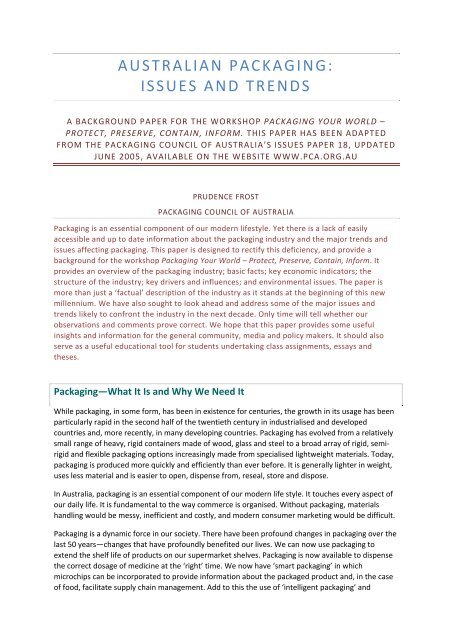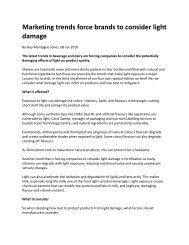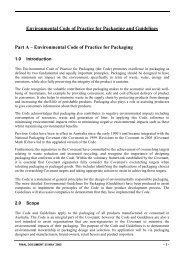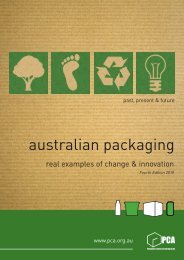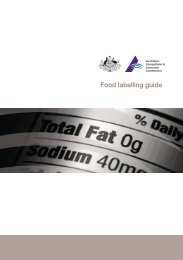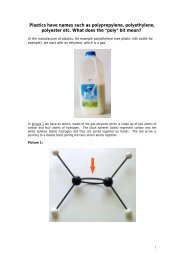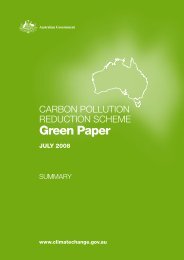australian packaging: issues and trends - the Packaging Council of ...
australian packaging: issues and trends - the Packaging Council of ...
australian packaging: issues and trends - the Packaging Council of ...
You also want an ePaper? Increase the reach of your titles
YUMPU automatically turns print PDFs into web optimized ePapers that Google loves.
AUSTRALIAN PACKAGING:<br />
ISSUES AND TRENDS<br />
A BACKGROUND PAPER FOR THE WORKSHOP PACKAGING YOUR WORLD –<br />
PROTECT, PRESERVE, CONTAIN, INFORM. THIS PAPER HAS BEEN ADAPTED<br />
FROM THE PACKAGING COUNCIL OF AUSTRALIA’S ISSUES PAPER 18, UPDATED<br />
JUNE 2005, AVAILABLE ON THE WEBSITE WWW.PCA.ORG.AU<br />
PRUDENCE FROST<br />
PACKAGING COUNCIL OF AUSTRALIA<br />
<strong>Packaging</strong> is an essential component <strong>of</strong> our modern lifestyle. Yet <strong>the</strong>re is a lack <strong>of</strong> easily<br />
accessible <strong>and</strong> up to date information about <strong>the</strong> <strong>packaging</strong> industry <strong>and</strong> <strong>the</strong> major <strong>trends</strong> <strong>and</strong><br />
<strong>issues</strong> affecting <strong>packaging</strong>. This paper is designed to rectify this deficiency, <strong>and</strong> provide a<br />
background for <strong>the</strong> workshop <strong>Packaging</strong> Your World – Protect, Preserve, Contain, Inform. It<br />
provides an overview <strong>of</strong> <strong>the</strong> <strong>packaging</strong> industry; basic facts; key economic indicators; <strong>the</strong><br />
structure <strong>of</strong> <strong>the</strong> industry; key drivers <strong>and</strong> influences; <strong>and</strong> environmental <strong>issues</strong>. The paper is<br />
more than just a ‘factual’ description <strong>of</strong> <strong>the</strong> industry as it st<strong>and</strong>s at <strong>the</strong> beginning <strong>of</strong> this new<br />
millennium. We have also sought to look ahead <strong>and</strong> address some <strong>of</strong> <strong>the</strong> major <strong>issues</strong> <strong>and</strong><br />
<strong>trends</strong> likely to confront <strong>the</strong> industry in <strong>the</strong> next decade. Only time will tell whe<strong>the</strong>r our<br />
observations <strong>and</strong> comments prove correct. We hope that this paper provides some useful<br />
insights <strong>and</strong> information for <strong>the</strong> general community, media <strong>and</strong> policy makers. It should also<br />
serve as a useful educational tool for students undertaking class assignments, essays <strong>and</strong><br />
<strong>the</strong>ses.<br />
<strong>Packaging</strong>—What It Is <strong>and</strong> Why We Need It<br />
While <strong>packaging</strong>, in some form, has been in existence for centuries, <strong>the</strong> growth in its usage has been<br />
particularly rapid in <strong>the</strong> second half <strong>of</strong> <strong>the</strong> twentieth century in industrialised <strong>and</strong> developed<br />
countries <strong>and</strong>, more recently, in many developing countries. <strong>Packaging</strong> has evolved from a relatively<br />
small range <strong>of</strong> heavy, rigid containers made <strong>of</strong> wood, glass <strong>and</strong> steel to a broad array <strong>of</strong> rigid, semirigid<br />
<strong>and</strong> flexible <strong>packaging</strong> options increasingly made from specialised lightweight materials. Today,<br />
<strong>packaging</strong> is produced more quickly <strong>and</strong> efficiently than ever before. It is generally lighter in weight,<br />
uses less material <strong>and</strong> is easier to open, dispense from, reseal, store <strong>and</strong> dispose.<br />
In Australia, <strong>packaging</strong> is an essential component <strong>of</strong> our modern life style. It touches every aspect <strong>of</strong><br />
our daily life. It is fundamental to <strong>the</strong> way commerce is organised. Without <strong>packaging</strong>, materials<br />
h<strong>and</strong>ling would be messy, inefficient <strong>and</strong> costly, <strong>and</strong> modern consumer marketing would be difficult.<br />
<strong>Packaging</strong> is a dynamic force in our society. There have been pr<strong>of</strong>ound changes in <strong>packaging</strong> over <strong>the</strong><br />
last 50 years—changes that have pr<strong>of</strong>oundly benefited our lives. We can now use <strong>packaging</strong> to<br />
extend <strong>the</strong> shelf life <strong>of</strong> products on our supermarket shelves. <strong>Packaging</strong> is now available to dispense<br />
<strong>the</strong> correct dosage <strong>of</strong> medicine at <strong>the</strong> ‘right’ time. We now have ‘smart <strong>packaging</strong>’ in which<br />
microchips can be incorporated to provide information about <strong>the</strong> packaged product <strong>and</strong>, in <strong>the</strong> case<br />
<strong>of</strong> food, facilitate supply chain management. Add to this <strong>the</strong> use <strong>of</strong> ‘intelligent <strong>packaging</strong>’ <strong>and</strong>
time/temperature indicators can be incorporated to provide effective monitoring <strong>of</strong> product quality<br />
from <strong>the</strong> producer to <strong>the</strong> consumer.<br />
<strong>Packaging</strong> uses a vast range <strong>of</strong> materials—adhesives, metals, glass, paper/board, plastics, films <strong>and</strong><br />
wood—ei<strong>the</strong>r singly or in various combinations. The design range is also vast, ranging from tubes to<br />
pouches, cartons to corrugated boxes to bulk containers, cans to bottles to drums. Add to <strong>the</strong>se<br />
materials <strong>and</strong> shapes an equal range <strong>of</strong> colours <strong>and</strong> special techniques such as holograms <strong>and</strong> <strong>the</strong><br />
range <strong>of</strong> options increases significantly.<br />
Consumer <strong>packaging</strong> has, by <strong>the</strong> time <strong>of</strong> its disposal, delivered significant benefits to <strong>the</strong> consumer. It<br />
has ensured <strong>the</strong> security <strong>of</strong> <strong>the</strong> product, delivered it in a clean, safe <strong>and</strong> saleable form <strong>and</strong> prevented<br />
spillage <strong>and</strong> spoilage. It has delivered substantial economies <strong>and</strong> <strong>the</strong>reby kept prices down by<br />
facilitating ease <strong>of</strong> h<strong>and</strong>ling, warehousing <strong>and</strong> distribution. <strong>Packaging</strong> has also reduced both <strong>the</strong><br />
amount <strong>of</strong> solid waste going to l<strong>and</strong>fill <strong>and</strong> <strong>the</strong> overall environmental impact associated with <strong>the</strong><br />
production <strong>and</strong> distribution <strong>of</strong> goods which has been beneficial to society.<br />
The Role <strong>of</strong> <strong>Packaging</strong><br />
<strong>Packaging</strong> has been defined as ‘all products made <strong>of</strong> any materials <strong>of</strong> any nature to be used for <strong>the</strong><br />
containment, protection, h<strong>and</strong>ling, delivery <strong>and</strong> presentation <strong>of</strong> goods, from raw materials to<br />
processed goods, from <strong>the</strong> producer to <strong>the</strong> user or <strong>the</strong> consumer’. The ultimate test <strong>of</strong> <strong>packaging</strong> is<br />
whe<strong>the</strong>r or not it performs its essential task—to contain, preserve <strong>and</strong> protect <strong>the</strong> product <strong>and</strong> to<br />
provide information about <strong>the</strong> contents <strong>of</strong> <strong>the</strong> package.<br />
In <strong>the</strong> past, this functional aspect <strong>of</strong> <strong>the</strong> role <strong>of</strong> <strong>packaging</strong>—preservation <strong>and</strong> product security—has<br />
been taken for granted by <strong>the</strong> general community. This has changed in recent years with a number <strong>of</strong><br />
incidents in Australia involving <strong>the</strong> willful tampering <strong>and</strong> despoliation <strong>of</strong> packaged products. Product<br />
security is now a major global issue for all companies involved in <strong>the</strong> <strong>packaging</strong> supply chain.<br />
Product security is just one example <strong>of</strong> <strong>the</strong> increasing dem<strong>and</strong> being made <strong>of</strong> <strong>packaging</strong>. These<br />
dem<strong>and</strong>s are being driven by consumers, business pressures, a range <strong>of</strong> social <strong>and</strong> demographic<br />
changes, technological innovation <strong>and</strong> <strong>the</strong> need to respond to environmental concerns.<br />
Consumers are certainly dem<strong>and</strong>ing more from <strong>packaging</strong>—convenience, differing product sizes,<br />
easy opening (but also child resistant closures <strong>and</strong> tamper evident) devices, respect for <strong>the</strong><br />
environment, <strong>and</strong> minimal cost for packaged products. Convenience foods, individually packed small<br />
serves, microwavable meals, ‘easy‐opening’ <strong>packaging</strong>, Home Meal Replacements, secure <strong>packaging</strong><br />
for pharmaceuticals <strong>and</strong> hazardous substances are all examples <strong>of</strong> <strong>packaging</strong> playing a role in<br />
assisting <strong>and</strong> promoting our lifestyles.<br />
<strong>Packaging</strong> has an important marketing role. It is <strong>the</strong> ‘flagbearer’ <strong>of</strong> br<strong>and</strong>ed products. <strong>Packaging</strong> plays<br />
an important role in differentiating competing products <strong>and</strong> can be decisive in influencing <strong>the</strong><br />
purchasing choice made by consumers. The package as a deliverer <strong>of</strong> br<strong>and</strong> equity has to work not<br />
only on <strong>the</strong> retail shelf but ‘online’ as well.
Types <strong>of</strong> <strong>Packaging</strong><br />
Traditionally, three broad categories <strong>of</strong> <strong>packaging</strong> have been identified:<br />
1. Consumer <strong>packaging</strong> or primary <strong>packaging</strong> i.e., <strong>packaging</strong> which constitutes a sales unit to<br />
<strong>the</strong> final user or consumer at <strong>the</strong> point <strong>of</strong> purchase.<br />
2. Grouped <strong>packaging</strong> or secondary <strong>packaging</strong> i.e., <strong>packaging</strong> which constitutes, at <strong>the</strong> point <strong>of</strong><br />
purchase, a grouping <strong>of</strong> a certain number <strong>of</strong> sales units, whe<strong>the</strong>r <strong>the</strong> latter is sold as such to<br />
<strong>the</strong> final user, or consumer, or whe<strong>the</strong>r it serves only as a means to replenish <strong>the</strong> shelves at<br />
<strong>the</strong> point <strong>of</strong> sale. It can be removed from <strong>the</strong> product without affecting its characteristics.<br />
3. Transport <strong>packaging</strong> or tertiary <strong>packaging</strong> i.e., <strong>packaging</strong> designed to facilitate h<strong>and</strong>ling <strong>and</strong><br />
transport <strong>of</strong> a number <strong>of</strong> sales units or grouped <strong>packaging</strong> in order to prevent physical<br />
h<strong>and</strong>ling <strong>and</strong> transport damage.<br />
Increasingly, manufacturers are looking to merge—or better co‐ordinate—<strong>the</strong> functions performed<br />
by <strong>the</strong>se levels <strong>of</strong> <strong>packaging</strong> in order to reduce costs <strong>and</strong> facilitate good presentation. <strong>Packaging</strong><br />
suppliers are helping to develop innovative ways to achieve this with <strong>the</strong> total cost being less than<br />
<strong>the</strong> sum <strong>of</strong> <strong>the</strong> original parts <strong>and</strong> with functionality ei<strong>the</strong>r unimpaired or improved.<br />
AUSTRALIAN PACKAGING—AN OVERVIEW<br />
KEY STATISTICS<br />
‣ The value <strong>of</strong> <strong>packaging</strong> produced in Australia is estimated to be $AUD10–10.5 billion. By<br />
international st<strong>and</strong>ards <strong>the</strong> Australian market is extremely small. The value <strong>of</strong> world<br />
<strong>packaging</strong> is estimated to be $US300 billion.<br />
‣ The Australian industry accounts for slightly in excess <strong>of</strong> 1% <strong>of</strong> GDP.<br />
‣ About 30,000 people are directly employed in <strong>the</strong> production <strong>of</strong> <strong>packaging</strong> in Australia.<br />
‣ The two major <strong>packaging</strong> manufacturers in Australia are Australian owned as are a<br />
substantial proportion <strong>of</strong> small <strong>and</strong> medium enterprises (SME).<br />
‣ Generally, most <strong>packaging</strong> produced in Australia (as elsewhere) is a high volume/low margin<br />
business.<br />
‣ ‘Value added’ <strong>packaging</strong> is where <strong>the</strong> margins (<strong>and</strong> costs) are higher. The drivers for such<br />
<strong>packaging</strong> are, however, <strong>of</strong>ten in conflict with, <strong>and</strong> subordinate to, <strong>the</strong> pressures for cost<br />
reductions.
PACKAGING MATERIALS<br />
The major <strong>packaging</strong> materials used in Australia are glass, metals (aluminium <strong>and</strong> steel), paper/board<br />
(cartons <strong>and</strong> corrugated), <strong>and</strong> plastics (HDPE, PET, PVC, polypropylene <strong>and</strong> polystyrene). Paper/board<br />
<strong>packaging</strong> is <strong>the</strong> largest single material constituting about 36% <strong>of</strong> <strong>the</strong> total Australian <strong>packaging</strong><br />
market. Plastics has gained significant market share to be <strong>the</strong> second largest sector (30%), with<br />
flexibles increasing at <strong>the</strong> expense <strong>of</strong> rigid plastics. (In <strong>the</strong> early 1960s plastics had less than 10% <strong>of</strong><br />
<strong>the</strong> share <strong>of</strong> <strong>the</strong> <strong>packaging</strong> market.) Metal <strong>packaging</strong> has lost market share in food applications but<br />
still accounts for 20%, with glass at 10%. O<strong>the</strong>r types <strong>of</strong> <strong>packaging</strong> make up <strong>the</strong> remainder.<br />
PACKAGING INDUSTRY<br />
Size matters in <strong>the</strong> business <strong>of</strong> <strong>packaging</strong>. Concentration <strong>and</strong> consolidation have been a feature <strong>of</strong><br />
<strong>the</strong> Australian <strong>packaging</strong> industry over <strong>the</strong> last decade. The degree <strong>of</strong> concentration <strong>of</strong> <strong>the</strong> Australian<br />
<strong>packaging</strong> industry can be seen from <strong>the</strong> following:<br />
‣ Glass containers: There are now two glass container producers in Australia (O‐I <strong>and</strong> Amcor).<br />
Amcor commenced producing wine bottles from its Gawler plant in South Australia in mid<br />
2002.<br />
‣ Corrugated boxes: Three companies (Amcor, Visy <strong>and</strong> Carter Holt Harvey) account for over<br />
95% <strong>of</strong> <strong>the</strong> production <strong>of</strong> corrugated boxes.<br />
‣ Aluminium cans: Two companies (Amcor <strong>and</strong> Visy) produce all <strong>the</strong> aluminium cans<br />
manufactured in Australia.<br />
‣ Liquidpaperboard cartons: Tetra Pak <strong>and</strong> Visy produce all <strong>the</strong> liquidpaperboard cartons<br />
manufactured in Australia.<br />
‣ Steel cans: There are approximately six companies producing steel cans/drums/aerosol<br />
containers/general line in Australia (Amcor, Huhtamaki, Irwin & Sheehan, Morris McMahon,<br />
National Can, <strong>and</strong> Visy).
‣ Plastics: Overall, <strong>the</strong> least concentrated <strong>packaging</strong> material sector (with <strong>the</strong> lowest barriers<br />
to entry), although in some sectors e.g., <strong>the</strong> manufacture <strong>of</strong> PET bottles, <strong>the</strong>re are just a few<br />
producers.<br />
Why is this trend towards concentration occurring It is not unique to Australia. The manufacture <strong>of</strong><br />
consumer products is an increasingly global business. The largest users <strong>of</strong> Australian <strong>packaging</strong> are,<br />
increasingly, multinational companies or Australian based companies with significant export markets<br />
who dem<strong>and</strong> that <strong>the</strong> price <strong>and</strong> quality <strong>of</strong> Australian <strong>packaging</strong> meet international st<strong>and</strong>ards. This<br />
has led to rationalisation <strong>of</strong> <strong>the</strong> manufacture <strong>and</strong> purchase <strong>of</strong> <strong>packaging</strong> <strong>and</strong> has compelled<br />
<strong>packaging</strong> suppliers to think in terms <strong>of</strong> similar enlargement.<br />
Will this trend continue Overall, <strong>the</strong> answer is yes but with some important qualifications:<br />
‣ Consolidation is most likely in <strong>the</strong> plastics sector where <strong>the</strong>re are still numerous small<br />
operators.<br />
‣ In many <strong>of</strong> <strong>the</strong> o<strong>the</strong>r sectors listed above, concentration has probably reached its limit with<br />
only two producers <strong>and</strong> with <strong>the</strong> competition authority, <strong>the</strong> ACCC, not likely to approve<br />
mergers or acquisitions by one <strong>of</strong> <strong>the</strong> o<strong>the</strong>r.<br />
According to conventional wisdom, <strong>the</strong> future in <strong>the</strong> <strong>packaging</strong> manufacturing sector lies with <strong>the</strong><br />
large, globally focused companies on <strong>the</strong> one h<strong>and</strong>, <strong>and</strong> small, agile, innovative companies on <strong>the</strong><br />
o<strong>the</strong>r. Those caught in <strong>the</strong> middle are vulnerable.<br />
Despite <strong>the</strong> concentration <strong>and</strong> consolidation in <strong>the</strong> industry, competition between companies <strong>and</strong><br />
material types remains intense. Competitive pressures are produced by imports, competition from<br />
alternative <strong>packaging</strong> types <strong>and</strong> <strong>the</strong> dem<strong>and</strong>s by <strong>the</strong> major users <strong>of</strong> <strong>packaging</strong> that Australian<br />
<strong>packaging</strong> meet international best practice st<strong>and</strong>ards.<br />
The Australian <strong>packaging</strong> industry has been criticised from time to time for being uncompetitive—<br />
high cost <strong>and</strong> poor in terms <strong>of</strong> innovation. Much <strong>of</strong> this criticism lacks substance <strong>and</strong> is self‐serving.<br />
Nowadays <strong>the</strong> Australian <strong>packaging</strong> industry is outward looking <strong>and</strong> export oriented to an<br />
unprecedented degree. Like most manufacturing industries in Australia, some parts <strong>of</strong> <strong>the</strong> <strong>packaging</strong><br />
industry suffer on account <strong>of</strong> scale. This means that <strong>the</strong> discounts attainable from long production<br />
runs are probably not available to users <strong>of</strong> <strong>packaging</strong> to <strong>the</strong> same extent as in <strong>the</strong> United States <strong>and</strong><br />
Europe.<br />
<strong>Packaging</strong>—The Drivers, Trends <strong>and</strong> Issues<br />
Following are some <strong>of</strong> <strong>the</strong> major <strong>trends</strong> <strong>and</strong> influences that will affect <strong>the</strong> <strong>packaging</strong> supply chain<br />
over <strong>the</strong> next decade:<br />
Electronic business processes<br />
Electronic technology is having <strong>the</strong> most effect in business‐to‐business (B2B) ra<strong>the</strong>r than in businessto‐consumer<br />
(B2C) relationships. Speed to market is crucial. New products are being developed<br />
faster <strong>and</strong> entering <strong>the</strong> retail market much more quickly. Electronic business processes are linking<br />
<strong>the</strong> entire supply chain—raw material suppliers, <strong>packaging</strong> manufacturers, <strong>packaging</strong> users, retailers<br />
<strong>and</strong> consumers. This provides immediate <strong>and</strong> accurate information, reduces costs <strong>and</strong> time delays,<br />
simplifies logistics <strong>and</strong> inventory operations <strong>and</strong> provides a better response to consumer dem<strong>and</strong>s.<br />
<strong>Packaging</strong> customers now have online access to <strong>the</strong>ir suppliers' manufacturing logistics systems <strong>and</strong>
vice versa. This enables relatively seamless progress from initiation <strong>of</strong> product requirements through<br />
to order placement, manufacturing, delivery, invoicing <strong>and</strong> distribution. The increasing<br />
implementation <strong>of</strong> <strong>packaging</strong> optimisation s<strong>of</strong>tware will dovetail with developments in logistics<br />
technology to increase total pack efficiency. Deliveries within <strong>the</strong> logistics chain will become<br />
increasingly complex, with direct store delivery, central warehousing, distribution centres, product<br />
picking <strong>and</strong> robotic scanning. The role <strong>of</strong> <strong>the</strong> logistics pr<strong>of</strong>essional will become increasingly important<br />
to <strong>the</strong> <strong>packaging</strong> industry.<br />
Supply chain management<br />
All companies in <strong>the</strong> supply chain are under constant pressure to drive down costs, including <strong>the</strong> cost<br />
<strong>of</strong> <strong>packaging</strong>. At every point in <strong>the</strong> supply chain, costs are added. Reducing those costs, simplifying<br />
<strong>the</strong> supply chain <strong>and</strong> increasing efficiency is now a major goal. Economies <strong>and</strong> competitive advantage<br />
are to be gained from a more integrated, collaborative, co‐operative <strong>and</strong> long‐term approach to <strong>the</strong><br />
supply chain by <strong>the</strong> companies involved.<br />
Convenience <strong>packaging</strong><br />
Consumers are dem<strong>and</strong>ing a wider range <strong>of</strong> products <strong>and</strong> greater segmentation (by size, flavour)<br />
within those products. Convenience/quick preparation foods providing smaller/single serve portions<br />
are in dem<strong>and</strong>. Pre‐cut, pre‐portioned, smaller, ready‐to‐consume products are increasingly popular,<br />
reflecting <strong>the</strong> importance <strong>of</strong> convenience to today's consumers. Packs that go from <strong>the</strong> shelf or bin<br />
straight into <strong>the</strong> fridge or straight into <strong>the</strong> oven. Packs that are easy to open, dispense, reseal <strong>and</strong><br />
store. Convenience <strong>packaging</strong> goes beyond <strong>the</strong> essential purpose <strong>of</strong> preserving <strong>and</strong> protecting <strong>the</strong><br />
product. Consumers want conveniently packaged food products that can be quickly made into meals<br />
without sacrificing quality. This is obvious in <strong>the</strong> range <strong>of</strong> products displayed in supermarkets—<br />
microwavable products, salad kits, zippered pouches <strong>and</strong> modified atmosphere <strong>packaging</strong>—that<br />
extends shelf‐life <strong>and</strong> maintains freshness. A by‐product <strong>of</strong> this dem<strong>and</strong> will be an increase in <strong>the</strong><br />
amount <strong>of</strong> <strong>packaging</strong> per food unit.<br />
Marketability<br />
<strong>Packaging</strong> sells products. Many <strong>of</strong> <strong>the</strong> <strong>trends</strong> listed above—lifestyle changes, greater product<br />
differentiation, competitive pressures—are putting an even greater premium on <strong>the</strong> look, sales<br />
appeal <strong>and</strong> quality <strong>of</strong> retail <strong>packaging</strong>. Greater versatility <strong>of</strong> product presentation will also be called<br />
for as an expression <strong>of</strong> <strong>the</strong> increasingly diverse <strong>and</strong> sophisticated dem<strong>and</strong>s <strong>of</strong> consumers. There will<br />
be an increasing dem<strong>and</strong> for higher quality graphics <strong>and</strong> promotional links between graphics <strong>and</strong><br />
advertising.<br />
<strong>Packaging</strong> for an ageing population<br />
The proportion <strong>of</strong> <strong>the</strong> elderly (over 65 years) is expected to increase to 22% <strong>of</strong> <strong>the</strong> population in <strong>the</strong><br />
first half <strong>of</strong> <strong>the</strong> century compared with <strong>the</strong> current 12% approximately. The ‘greying’ <strong>of</strong> <strong>the</strong><br />
Australian population will increase <strong>the</strong> emphasis on <strong>the</strong> provision <strong>of</strong> easy‐opening systems,<br />
consistent with ‘tamper evident’ closures. Readability <strong>of</strong> labels for <strong>the</strong> aged <strong>and</strong> visually impaired will<br />
also require attention in <strong>the</strong> designing <strong>and</strong> labelling <strong>of</strong> <strong>packaging</strong>. Given <strong>the</strong>ir numbers <strong>and</strong> affluence,<br />
marketing will reflect this changing composition <strong>of</strong> <strong>the</strong> population.
O<strong>the</strong>r dem<strong>and</strong>s<br />
The list <strong>of</strong> dem<strong>and</strong>s made on <strong>packaging</strong> will also include <strong>the</strong> following:<br />
‣ Freshness—While consumers want convenience, <strong>the</strong>y also want freshness. In <strong>the</strong> United<br />
States <strong>and</strong> Europe, sales <strong>of</strong> products in modified atmosphere <strong>packaging</strong> are increasing<br />
significantly. O<strong>the</strong>r products to extend shelf life are also gaining ground.<br />
‣ Tamper Evidence—The dem<strong>and</strong> for tamper evident <strong>packaging</strong> will increase ‐ that is,<br />
<strong>packaging</strong> which possesses a barrier to entry which, if breached or missing, will provide<br />
visible evidence to consumers that tampering had occurred.<br />
‣ Labelling—The dem<strong>and</strong>s on labels to provide information will increase. Instruction details,<br />
nutritional information, promotional material, bar‐coding, environmental aspects, etc., will<br />
all need to be included on a st<strong>and</strong>ard label.<br />
There is ‘tension’ between <strong>the</strong>se drivers with some pushing in opposing directions:<br />
‣ There is some evidence to suggest that <strong>the</strong> range <strong>of</strong> <strong>packaging</strong> materials used by<br />
companies may be growing less compatible with existing post‐consumer recycling<br />
services.<br />
‣ The environmental <strong>and</strong> commercial dem<strong>and</strong> for reduced <strong>packaging</strong> needs to be balanced<br />
against <strong>the</strong> paramount requirement for product security which can lead to an increase in<br />
<strong>packaging</strong> e.g., tamper evident devices.<br />
‣ While commercial <strong>and</strong> environmental pressures are requiring a reduction in <strong>the</strong> amount<br />
<strong>of</strong> <strong>packaging</strong>, <strong>the</strong> requirement for convenience/quick preparation foods which are<br />
individually packaged in single or small serves is increasing <strong>and</strong>, in turn, is leading to an<br />
increase in <strong>the</strong> amount <strong>of</strong> <strong>packaging</strong> per food unit.<br />
‣ The requirement for ‘easy‐opening’ <strong>packaging</strong> can, at times, conflict with <strong>the</strong> dem<strong>and</strong><br />
that some products need to have child resistant closures.<br />
‣ The requirement for <strong>packaging</strong> to be more sophisticated <strong>and</strong> meet a range <strong>of</strong> needs is<br />
also leading to an increase in cost.<br />
The Environment<br />
For several decades <strong>the</strong> environment has been a major issue for <strong>packaging</strong> companies. All <strong>packaging</strong><br />
materials have <strong>the</strong>ir environmental pluses <strong>and</strong> minuses. A self regulatory Environmental Code <strong>of</strong><br />
Practice for <strong>Packaging</strong> has been in operation for many years <strong>and</strong> has recently been reviewed <strong>and</strong><br />
updated. It is designed to provide companies with practical guidelines to evaluate <strong>the</strong> impact <strong>of</strong> new<br />
<strong>and</strong> existing <strong>packaging</strong>. The driving forces behind <strong>the</strong> prominence <strong>of</strong> environmental <strong>issues</strong> for<br />
<strong>packaging</strong> are threefold—consumers, commercial factors <strong>and</strong> governments.<br />
‣ Consumers are showing more interest in <strong>the</strong> environmental credentials <strong>of</strong> <strong>the</strong> products <strong>the</strong>y<br />
buy <strong>and</strong> <strong>the</strong> companies <strong>the</strong>y buy from.<br />
‣ Commercially, supply chain factors are playing a role as companies respond to <strong>the</strong><br />
environmental challenge. Some retail chains have banned what <strong>the</strong>y consider to be<br />
environmentally unacceptable <strong>packaging</strong> such as polystyrene boxes. There will be more, not
less, <strong>of</strong> this type <strong>of</strong> action from retailers around <strong>the</strong> world. They are responding to pressure<br />
from <strong>the</strong>ir customers <strong>and</strong> from governments. Commercial reality will ensure that it will be<br />
comparatively rare for a company to package a product deliberately with more <strong>packaging</strong><br />
than is necessary thus increasing cost <strong>and</strong>, <strong>the</strong>reby, making <strong>the</strong> product less competitive.<br />
‣ Governments around <strong>the</strong> world, particularly in Europe but more recently in North Asia, have<br />
targeted <strong>packaging</strong> for environmental legislation. Government measures have ranged from<br />
container deposits, <strong>packaging</strong> levies, bans on certain types <strong>of</strong> <strong>packaging</strong> <strong>and</strong> m<strong>and</strong>ating<br />
recycling rates. Pressure to introduce similar measures was undoubtedly building in <strong>the</strong><br />
1990s. The PCA decided, <strong>the</strong>refore, that in conjunction with government it would commence<br />
negotiations on a national <strong>packaging</strong> covenant.<br />
The National <strong>Packaging</strong> Covenant<br />
The first National <strong>Packaging</strong> Covenant was launched in August 1999. This Covenant was extensively<br />
reviewed in 2004 <strong>and</strong> revised in response to <strong>the</strong> findings <strong>of</strong> evaluations <strong>and</strong> a general agreement by<br />
stakeholders that <strong>the</strong> model needed to be significantly streng<strong>the</strong>ned if it was to continue. A new <strong>and</strong><br />
streng<strong>the</strong>ned Covenant became effective in July 2005 <strong>and</strong> incorporates changes made to achieve<br />
substantially improved performance.<br />
There are now over 450 signatories, <strong>of</strong> which over 400 are companies <strong>and</strong> industry associations in<br />
<strong>the</strong> <strong>packaging</strong> supply chain. All Australian, State, Territory (with <strong>the</strong> exception <strong>of</strong> <strong>the</strong> Nor<strong>the</strong>rn<br />
Territory) <strong>and</strong> Local governments are signatories to <strong>the</strong> Covenant. Local Government organisations<br />
from all States except NSW are also signatories.<br />
An up to date list <strong>of</strong> Covenant signatories, toge<strong>the</strong>r with <strong>the</strong> text <strong>of</strong> <strong>the</strong> Covenant <strong>and</strong> supporting<br />
regulatory safety net (<strong>the</strong> NEPM), can be found on <strong>the</strong> <strong>Packaging</strong> <strong>Council</strong> <strong>of</strong> Australia homepage.<br />
The Covenant is <strong>the</strong> voluntary component <strong>of</strong> a co‐regulatory arrangement for managing <strong>the</strong><br />
environmental impacts <strong>of</strong> consumer <strong>packaging</strong> in Australia. It is an agreement based on <strong>the</strong><br />
principals <strong>of</strong> shared responsibility through product stewardship, between key stakeholders in <strong>the</strong><br />
<strong>packaging</strong> supply chain <strong>and</strong> all spheres <strong>of</strong> government. Previous environmental policy for <strong>packaging</strong><br />
had focused on <strong>packaging</strong> materials ra<strong>the</strong>r than <strong>the</strong> entire <strong>packaging</strong> supply chain.<br />
The Covenant is designed to minimise <strong>the</strong> environmental impacts arising from <strong>the</strong> disposal <strong>of</strong> used<br />
<strong>packaging</strong>, conserve resources through better design <strong>and</strong> production processes <strong>and</strong> facilitate <strong>the</strong> reuse<br />
<strong>and</strong> recycling <strong>of</strong> <strong>packaging</strong> materials.<br />
The Covenant establishes a framework for <strong>the</strong> effective life cycle management <strong>of</strong> consumer<br />
<strong>packaging</strong> <strong>and</strong> paper products that will be delivered through a collaborative approach between all<br />
sectors <strong>of</strong> <strong>the</strong> <strong>packaging</strong> supply chain, consumers, collectors, reprocessors <strong>and</strong> government.<br />
The streng<strong>the</strong>ned National <strong>Packaging</strong> Covenant has a term <strong>of</strong> five years (2005‐10) <strong>and</strong> incorporates a<br />
number <strong>of</strong> changes designed to provide a more rigorous compliance <strong>and</strong> enforcement process<br />
including:<br />
1. Overarching Covenant Targets for 2010 (refer to Recycling section below for more<br />
details).<br />
2. Specific Covenant Performance Goals
3. Key Performance Indicators<br />
4. A Broader Scope<br />
• The Covenant now includes <strong>the</strong> recovery <strong>and</strong> re‐use <strong>of</strong> <strong>packaging</strong> materials<br />
consumed away from home – workplaces, commercial & industrial premises.<br />
Material collected in kerbside systems will continue to be a focus <strong>of</strong> <strong>the</strong> new<br />
covenant.<br />
• Signatories must address in‐house & distribution <strong>packaging</strong> <strong>and</strong> <strong>issues</strong> <strong>of</strong><br />
litter, market development for recycled materials <strong>and</strong> consumer awareness<br />
in <strong>the</strong>ir Action Plans.<br />
Recycling<br />
Companies in <strong>the</strong> <strong>packaging</strong> supply chain have a long history <strong>of</strong> actively supporting recycling,<br />
including <strong>the</strong> kerbside collection system. They have also invested heavily in recycling infrastructure<br />
<strong>and</strong> <strong>the</strong> buy back <strong>of</strong> recyclates. The use <strong>of</strong> recycled content in <strong>packaging</strong> is now widespread. Recycled<br />
<strong>packaging</strong> is also used to make a variety <strong>of</strong> o<strong>the</strong>r (non‐<strong>packaging</strong>) products. Companies in <strong>the</strong><br />
<strong>packaging</strong> supply chain will continue to make significant investments in capital infrastructure for<br />
recycling.<br />
Assessing <strong>the</strong> effectiveness <strong>of</strong> different recycling systems <strong>and</strong> <strong>the</strong> environmental impact <strong>of</strong> different<br />
types <strong>of</strong> <strong>packaging</strong> is a complex task. While recycling is widespread <strong>and</strong> popular it is not <strong>the</strong> sole test<br />
<strong>of</strong> <strong>the</strong> environmental credentials <strong>of</strong> all <strong>packaging</strong>. The first study conducted by <strong>the</strong> National<br />
<strong>Packaging</strong> Covenant <strong>Council</strong> was an ‘Independent Assessment <strong>of</strong> Kerbside Recycling in Australia’.<br />
Among <strong>the</strong> conclusions <strong>of</strong> this Assessment were <strong>the</strong> following:<br />
‘… THE CURRENT KERBSIDE SYSTEM IN METROPOLITAN AND REGIONAL CENTRES PROVIDES A<br />
TOTAL NET BENEFIT TO AUSTRALIAN COMMUNITIES. THIS STUDY HAS ASSESSED THE FINANCIAL<br />
AND ENVIRONMENTAL COSTS AND BENEFITS IN METROPOLITAN AND REGIONAL AREAS BY<br />
AVERAGING THE COSTS FOR BOTH AREAS IN ALL STATES AND TERRITORIES. WHILST BY<br />
DEFINITION REGIONAL AREAS INCLUDES PROVINCIAL AND RURAL TOWNS AS WELL AS REMOTE<br />
COMMUNITIES, THE ASSESSMENT RESULTS HAVE TO SOME DEGREE BEEN LIMITED FOR RURAL<br />
TOWNS AND REMOTE COMMUNITIES DUE TO BOTH LOW DATA AVAILABILITY AND THE LACK OF<br />
KERBSIDE SERVICES IN MANY OF THESE COMMUNITIES.’<br />
• Under <strong>the</strong> new National <strong>Packaging</strong> Covenant, an overarching recycling rate <strong>of</strong> 65% (currently<br />
48%) has been agreed by Ministers by 2010, with contributions from:<br />
‐ paper <strong>and</strong> cardboard 70‐80% (currently 64%)<br />
‐ plastics 30‐35% (currently 20%)<br />
‐ aluminium 70‐75% (currently 64%)<br />
‐ steel 60‐65% (currently 44%)<br />
‐ glass 50‐60% (currently 35%)<br />
‐ o<strong>the</strong>r materials 25% (currently 10%)
‐ no fur<strong>the</strong>r increase in <strong>the</strong> amount <strong>of</strong> <strong>packaging</strong> waste disposed to l<strong>and</strong>fill<br />
In short, recycling will remain a prominent issue for companies in <strong>the</strong> <strong>packaging</strong> supply chain<br />
The Outlook – What Lies Ahead<br />
For companies in <strong>the</strong> <strong>packaging</strong> supply chain <strong>the</strong>re is one incontestable conclusion ‐ <strong>the</strong> dem<strong>and</strong>s<br />
<strong>and</strong> pressures will not abate. Indeed, <strong>the</strong>y will intensify. Globalisation is here to stay. The<br />
technological age with all its ramifications has only just begun. Tight controls on costs will remain in<br />
place. Australian <strong>packaging</strong> will need to be internationally competitive.<br />
The specifics are as follows<br />
‣ Efficiency: In <strong>the</strong> business world <strong>of</strong> <strong>the</strong> 21st century we can no longer expect to retain our<br />
customers' business unless we're continually increasing efficiency—efficiency in our<br />
processes, in our product cost <strong>and</strong> in our business transactions.<br />
‣ <strong>Packaging</strong> materials: Lighter weight, higher performing <strong>packaging</strong> materials are under<br />
constant development, as are structural designs, which provide <strong>the</strong> same level <strong>of</strong> product<br />
protection at a lower cost.<br />
‣ <strong>Packaging</strong> suppliers: Increasingly, major <strong>packaging</strong> suppliers are evolving toward becoming<br />
total <strong>packaging</strong> systems suppliers. <strong>Packaging</strong> systems <strong>and</strong> carton erecting machinery which<br />
cut labour costs are also becoming more commonplace. They're also becoming more tailored<br />
to meet <strong>the</strong> needs <strong>of</strong> <strong>the</strong>ir specific market.<br />
‣ Machinery: Equipment suppliers are <strong>of</strong>fering new machinery to rationalise <strong>packaging</strong><br />
operations. Multi‐function systems are reducing <strong>the</strong> space required for packing lines <strong>and</strong> <strong>the</strong><br />
number <strong>of</strong> steps in <strong>the</strong> <strong>packaging</strong> process.<br />
‣ <strong>Packaging</strong> design: Changing <strong>and</strong> more complex lifestyles have also strongly influenced<br />
<strong>packaging</strong> design. Pre‐cut, pre‐portioned, smaller, ready to consume products are<br />
increasingly popular, reflecting <strong>the</strong> importance <strong>of</strong> convenience to today's customers. Packs<br />
that go from <strong>the</strong> shelf or bin straight into <strong>the</strong> fridge or straight into <strong>the</strong> oven. Blister packs,<br />
microwaveable packs, zippered pouches, contoured shapes <strong>and</strong> carry h<strong>and</strong>les on outer packs<br />
are just some examples <strong>of</strong> this trend.<br />
‣ Logistics: Key logistics changes to <strong>the</strong> <strong>packaging</strong> industry will see increased customer choice,<br />
faster product delivery, increased manufacturing <strong>and</strong> inventory controls <strong>and</strong> increased<br />
supply chain management efficiency. In <strong>the</strong> very near future many <strong>packaging</strong> customers will<br />
have online access to <strong>the</strong>ir suppliers manufacturing logistics systems, as we will to <strong>the</strong>irs.<br />
This will enable relatively seamless progress from initiation <strong>of</strong> product requirement, through<br />
to order placement, manufacturing, delivery, invoicing <strong>and</strong> distribution.<br />
‣ New technology: Smarter <strong>packaging</strong> companies around <strong>the</strong> world are already using new<br />
technology to take costs out <strong>of</strong> <strong>the</strong>ir own systems. And <strong>the</strong>y're using Internet links to<br />
improve <strong>the</strong>ir relationships <strong>and</strong> performance with customers. And it's in our type <strong>of</strong><br />
industry—business to business—that will see <strong>the</strong> biggest impact <strong>of</strong> computer technology <strong>and</strong>
e‐commerce. It's those <strong>packaging</strong> companies who don't get proactive about <strong>the</strong>ir Internet<br />
strategies who will find <strong>the</strong>mselves being passed over by <strong>the</strong>ir customers.<br />
The first decade <strong>of</strong> <strong>the</strong> 21st century is likely to be no less frenetic than <strong>the</strong> last decade, with<br />
challenge <strong>and</strong> change being <strong>the</strong> order <strong>of</strong> <strong>the</strong> day. Companies that stagnate <strong>and</strong> look for <strong>the</strong> easy<br />
options simply will not survive. In order to survive <strong>and</strong> prosper, companies will need to be flexible<br />
<strong>and</strong> adaptable <strong>and</strong> invest, innovate <strong>and</strong> develop <strong>the</strong> appropriate skills base to meet <strong>the</strong> challenges<br />
ahead.<br />
SUMMARY<br />
• <strong>Packaging</strong> is essential in contemporary Australian society. It is an integral part <strong>of</strong> everyday life<br />
<strong>and</strong> brings real benefits to all Australians. It plays a key role in <strong>the</strong> production, preservation,<br />
distribution <strong>and</strong> marketing <strong>of</strong> goods. Consumer <strong>packaging</strong> has, by <strong>the</strong> time <strong>of</strong> its disposal,<br />
delivered significant benefits to <strong>the</strong> consumer.<br />
• Convenience, safety <strong>and</strong> environmental friendliness are <strong>the</strong> key requirements <strong>of</strong> <strong>packaging</strong>, with<br />
safety being <strong>of</strong> paramount importance.<br />
• Consumers are dem<strong>and</strong>ing more <strong>and</strong> more from <strong>packaging</strong>. Change is also being fostered by<br />
commercial pressures, social <strong>and</strong> demographic changes, technological developments <strong>and</strong><br />
environmental concerns. <strong>Packaging</strong> manufacturers are being required to respond to <strong>the</strong>se<br />
pressures by ‘value adding’ to <strong>the</strong>ir <strong>packaging</strong>.<br />
• Some key statistics for Australian <strong>packaging</strong> are as follows: <strong>the</strong> value <strong>of</strong> <strong>packaging</strong> produced in<br />
Australia is $AUD10‐10.5 billion; about 30,000 people are directly employed; 65‐70% <strong>of</strong><br />
Australian <strong>packaging</strong> is used by <strong>the</strong> food <strong>and</strong> beverage sector; <strong>and</strong> paper/board is <strong>the</strong> largest<br />
single <strong>packaging</strong> material followed by plastics, metal <strong>and</strong> glass. Australian owned companies are<br />
<strong>the</strong> dominant <strong>packaging</strong> manufacturers.<br />
• Increased concentration <strong>and</strong> consolidation have been hallmarks <strong>of</strong> <strong>the</strong> Australian <strong>packaging</strong><br />
industry over <strong>the</strong> last decade. This trend is not unique to Australia. The plastics sector is <strong>the</strong> most<br />
likely to witness fur<strong>the</strong>r consolidation. Some o<strong>the</strong>r sectors have probably reached <strong>the</strong> limits <strong>of</strong><br />
consolidation. Competition between Australian <strong>packaging</strong> companies <strong>and</strong> material types is<br />
considerable.<br />
• Major <strong>trends</strong> <strong>and</strong> influences on <strong>packaging</strong> over <strong>the</strong> next decade will be <strong>the</strong> need to add<br />
consumer value, electronic business processes, cost reduction/supply chain management,<br />
environmental <strong>issues</strong> <strong>and</strong> globalisation. Some <strong>of</strong> <strong>the</strong>se <strong>trends</strong> <strong>and</strong> influences are pushing in<br />
opposing directions.<br />
• The environment is a major issue for <strong>packaging</strong> supply chain companies. All sectors are<br />
contributing to programs <strong>and</strong> initiatives which minimise <strong>the</strong> adverse environmental effects <strong>of</strong><br />
<strong>packaging</strong>. All <strong>packaging</strong> materials have <strong>the</strong>ir environmental pluses. Overall, <strong>the</strong> <strong>packaging</strong><br />
industry has a strong record on recycling. The use <strong>of</strong> recycled content in <strong>packaging</strong> is now<br />
widespread.<br />
• There are now over 450 signatories to <strong>the</strong> second National <strong>Packaging</strong> Covenant, The Covenant<br />
has led to greater activity by many companies to improve <strong>the</strong> environmental performance <strong>of</strong><br />
<strong>the</strong>ir <strong>packaging</strong>.
The outlook for <strong>the</strong> <strong>packaging</strong> industry will continue to be challenging. <strong>Packaging</strong> won't disappear—<br />
but <strong>the</strong> dem<strong>and</strong>s on <strong>packaging</strong> <strong>and</strong> <strong>the</strong> companies that produce it will increase. More <strong>and</strong> more will<br />
be required <strong>of</strong> <strong>packaging</strong> by consumers, customers <strong>and</strong> governments. Companies will need to invest,<br />
innovate <strong>and</strong> develop <strong>the</strong> appropriate skills base to meet <strong>the</strong>se challenges.


